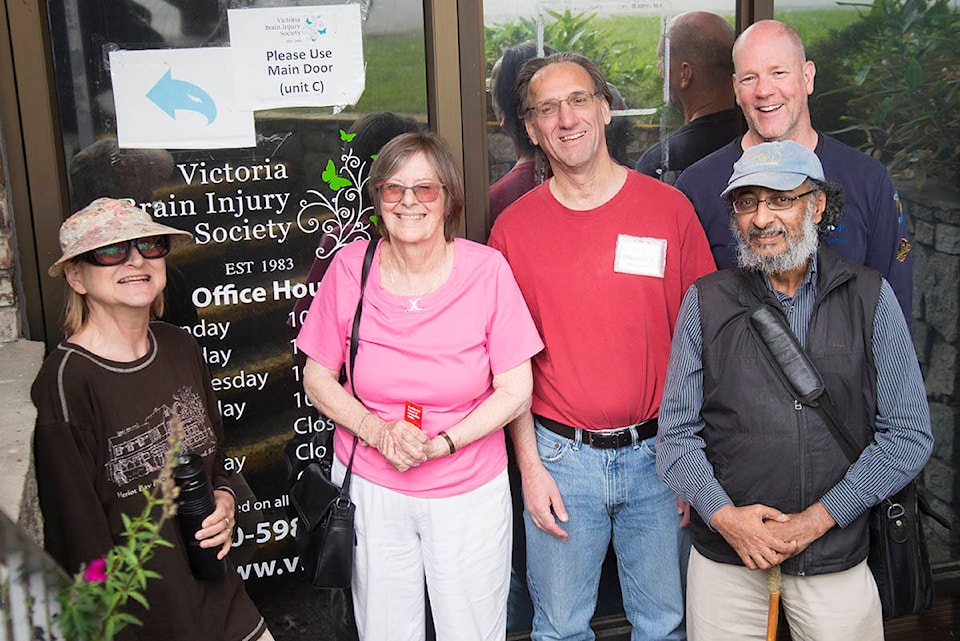Brenda Clayton was 28 years old when life as she knew it changed forever.
It was 1982 and she was a passenger in a car driving home to the Kootenays after a 10-year high school reunion at Esquimalt High. She was working as a Grade 1 teacher, a career she loved.
She doesn’t remember where, but Clayton knows that along a straight stretch of highway in B.C.’s interior, a drunk driver crossed the centre line and struck the vehicle she was in with her mom. Clayton would never be able to teach again.
READ ALSO: Victoria man suffered brain injuries, ongoing anxiety after assault near Strathcona Hotel
READ ALSO: How many drug users who OD’d have brain damage?
June is Brain Injury Awareness month, and Clayton, along with many of the clients and volunteers at the Victoria Brain Injury Society (VBIS), say there isn’t enough awareness, period.
According to the Northern Brain Injury Association, more than 400 people suffer a brain injury every day in Canada – that’s roughly one traumatic brain injury every three minutes.
And of the 165,000 serious brain injuries occurring per year in Canada, tens of thousands of Canadians become partially or permanently disabled, and more than 11,000 die.
“Once you’re brain injured, you’re brain injured for life,” Clayton said. “I always figured that I was going to get better. I thought, ‘I’m going to be a teacher again.’ But I couldn’t work, I couldn’t hold a job.”
James Sharp, a VBIS client and volunteer, has had repeated injuries to his head, at least two of them from cycling without a helmet.
“I didn’t grow up with one,” he shrugs. “I think that because I was an avid cyclist I always thought, I’m just going to put my arms out, I’m gonna fall right, it’s not going to happen to me.”
Ernano Angelozzi, who suffered a brain injury after falling from a second-storey balcony in 1992, said youth are vulnerable to head injuries – especially when they fail to wear a helmet.
“Young people tend to think they’re going to live forever and they take far too many chances,” he said. “It’s hard to predict other people’s behaviour too. You might think you’re fine out there but you never know what someone else is going to do, and that changes the situation completely.
People are a lot more vulnerable than they think, and that’s why a helmet can make the difference between a mild head injury and a severe one where you may not walk or talk again.”
Some injuries are milder – Sharp said many people don’t even know they have a brain injury. He suffered repeated head injuries throughout his life, his very fist when he was a little kid and hit his head on the bottom of a lake.
But some of the worst damage came from cycling without a helmet – a point Sharp emphasizes again and again.
“I knew back in the ‘80s that a small fall can alter your personality for life, and yet I still [didn’t wear a helmet] because I thought I was better and I thought it wouldn’t happen to me,” he recalled.
Now, if Sharp is out in the city and sees a cyclist without a helmet, especially youth who say they can’t afford one, he’ll give his away and walk his bike home.
“You need a helmet for cycling. You need a helmet for roller skating or blading, skateboarding, skiing, you name it – anything that makes you move faster or changes your balance. You have to have a helmet.
READ ALSO: Living with epilepsy has mental, emotional impacts says Victoria man
READ ALSO: Brain injury survivors in Victoria create word puzzle for international audience
Clayton noted helmets reduce risk of injury by at least 70 per cent and a fall from only two feet can cause permanent brain damage.
People just don’t know these things, she said.
Most of all, Clayton has lost her memory. She finds it difficult to remember what season or month it is. She now does outreach with the Prevent Alcohol-related Trauma in Youth program (P.A.R.T.Y program) – an educational outreach, interactive injury prevention program for youth.
The Victoria Brain Injury Society offers educational support groups, coping strategies, family groups and mindfulness, art, music, walking and yoga programs.
But overall, there just aren’t enough resources, says the group – and there is a total lack of awareness around the severity and types of brain injuries.
“A lot of people mistake it for psychological problems,” said Angelozzi. “They think having a brain injury is like being schizophrenic or bipolar but that’s not it at all. That’s a common misperception.”
Sharp said the impacts can vary – from day to day and from individual to individual.
“I think in a lot of cases you retain all of the intelligence you had, but you may have problems with memory and you may have problems taking information in and giving information out. It’s all in there, it’s just a lot more difficult to do … All it takes is one little fall.”
